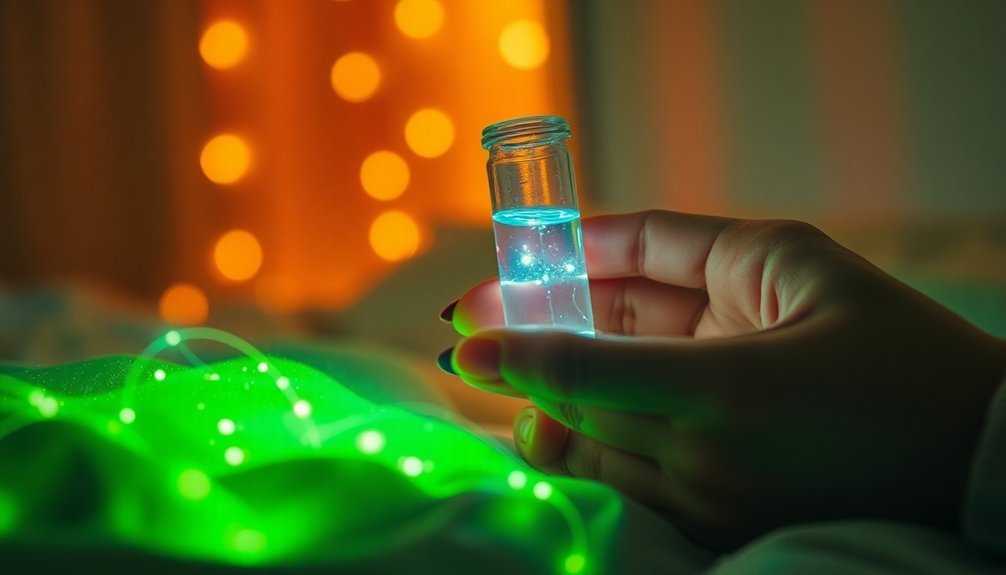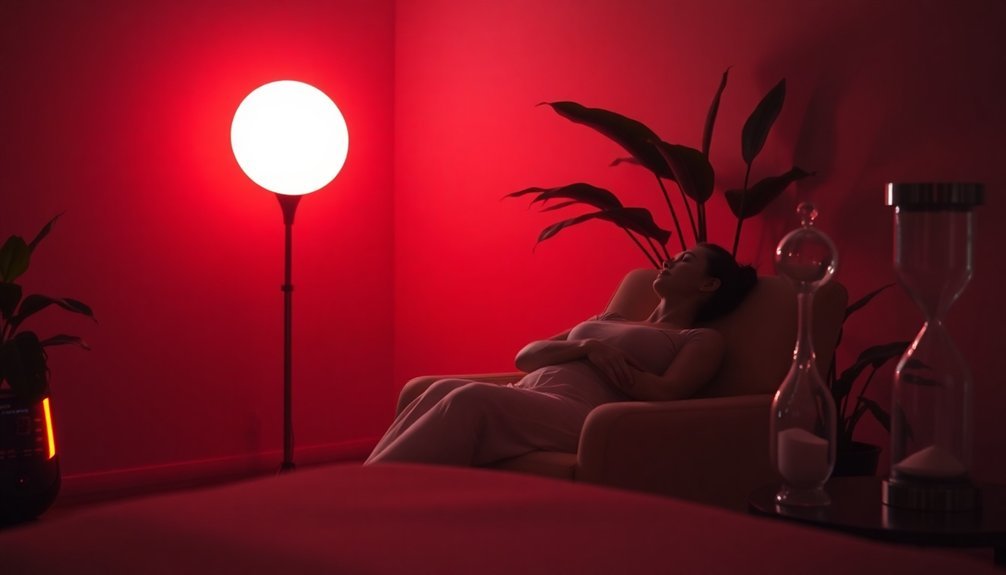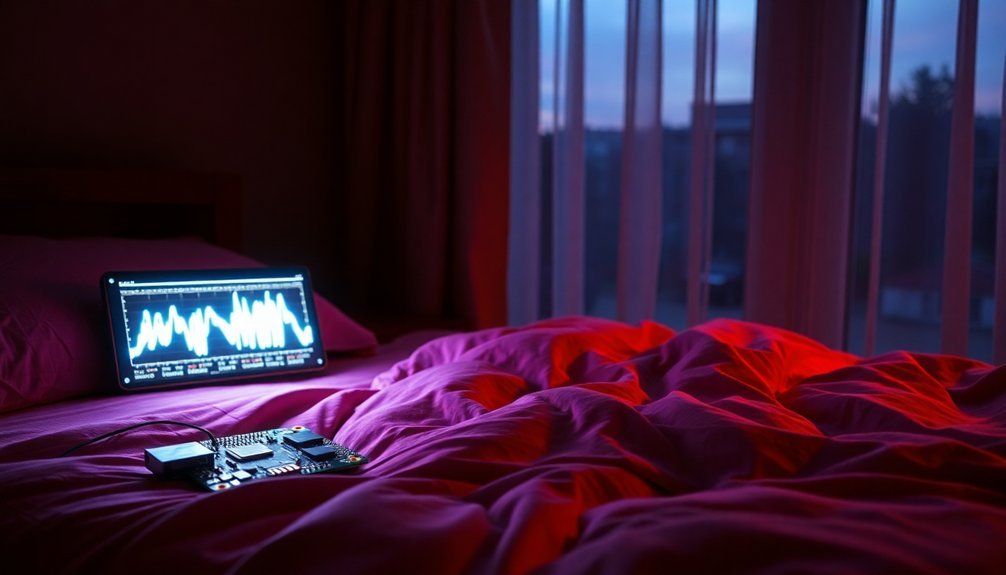Infrared exposure boosts melatonin production by stimulating mitochondrial activity, enhancing energy creation, and activating key enzymes in your body. When you're exposed to infrared light, especially in the evening, it can increase melatonin synthesis, promoting better sleep quality. The pineal gland, which regulates melatonin, responds favorably to this light, particularly wavelengths between 660-850 nanometers. Also, light influences your circadian rhythms, with proper exposure synchronizing your internal clock for improved hormone regulation. Understanding how infrared affects melatonin can lead you to discover more about its broader impacts on sleep and overall health.
Mechanisms of Melatonin Production

Melatonin production kicks off with the hydroxylation of L-tryptophan, a process facilitated by the enzyme tryptophan hydroxylase, which needs tetrahydrobiopterin (THB) and oxygen. This reaction converts L-tryptophan into 5-hydroxytryptophan (5-HTP).
Next, 5-HTP undergoes decarboxylation by the enzyme 5-hydroxytryptophan decarboxylase, turning it into serotonin. Once serotonin's formed, it's transformed into N-acetylserotonin through a reaction catalyzed by serotonin N-acetyltransferase, using acetyl-CoA.
The final step occurs when hydroxyindole O-methyltransferase methylates N-acetylserotonin, with S-adenosyl methionine serving as the methyl donor, yielding melatonin.
Regulation plays a crucial role here. Your pineal gland responds primarily to signals from the suprachiasmatic nuclei (SCN) of your hypothalamus, which senses the light/dark cycle. As darkness falls, norepinephrine is released from sympathetic fibers, ramping up melatonin production. It's essential to understand that enzymes like arylalkylamine N-acetyltransferase (AANAT) see significant activity surges at night due to these norepinephrine signals, enhancing melatonin production efficiently. Moreover, the environmental light-dark cycle significantly influences melatonin secretion, aligning it with the body's natural rhythms.
Infrared Light's Role
Harnessing the benefits of infrared light can greatly enhance melatonin production in your body. This type of light, especially near-infrared, actively supports melatonin levels. When you're exposed to sources like sunlight, campfires, or red-light therapy devices, you're stimulating melatonin production, particularly in the evening when your body naturally ramps it up.
Here's how infrared light works:
- It stimulates mitochondria, boosting energy production and melatonin synthesis.
- Infrared light triggers specific enzymes like cytochrome C oxidase, vital for melatonin production.
- Extrapineal melatonin, generated outside the pineal gland, is greatly impacted by infrared exposure.
- This light assists in maintaining your internal clock and enhances sleep quality.
You'll find infrared light in natural settings and devices—over 50% of sunlight consists of infrared energy essential for melatonin synthesis. Additionally, red light therapy (RLT) utilizes optimal wavelengths between 660-850 nanometers to improve melatonin production.
Even red-light therapy and infrared saunas can offer similar benefits. So, when you utilize these sources, you're not just enjoying warmth but actively promoting your body's melatonin production, which can lead to improved sleep and overall well-being.
Impact of Light Sources

Various light sources markedly influence your melatonin production and overall sleep quality. Natural light sources, like sunlight, provide a rich infrared spectrum that boosts melatonin levels. You can also benefit from the warm glow of candles or campfires, which naturally stimulate your body's melatonin. Evening light from sunsets, rich in red and orange wavelengths, is particularly helpful. Additionally, exposure to sunlight and near-infrared light enhances your body's capacity to produce melatonin, positively impacting your sleep quality.
Conversely, artificial light sources, especially blue light from devices, hinder melatonin production and disrupt your circadian rhythm. Bright LED lights at night trick your brain into thinking it's daytime, ultimately interfering with sleep.
Here's a table summarizing these contrasts:
| Light Source | Effect on Melatonin | Time of Day |
|---|---|---|
| Sunlight | Boosts production | Daytime |
| Candles/Fireplaces | Stimulates production | Evening |
| Blue Light | Suppresses production | Night |
Understanding these dynamics helps you create an environment that supports your melatonin production. By embracing natural light and minimizing exposure to artificial sources, you'll foster better sleep and a healthier routine.
Cellular and Mitochondrial Activity
The intricate relationship between cellular and mitochondrial activity reveals the essential role of melatonin in sustaining cellular functions and energy production. Inside your cells, melatonin is synthesized within mitochondria, acting as a powerful antioxidant. This significant compound aids in various processes that keep your cellular machinery functioning effectively:
- It mitigates reactive oxygen species (ROS) production, thereby protecting mitochondria from damage.
- Melatonin enhances the electron transport chain (ETC) and oxidative phosphorylation (OXPHOS), improving ATP synthesis.
- It regulates calcium levels and mitochondrial membrane potential, further boosting mitochondrial activity.
- Melatonin promotes fatty acid metabolism and influences glycolysis to enhance mitochondrial metabolism.
When you're exposed to near-infrared light—especially at sunrise and sunset—melatonin production kicks into gear, supporting energy production.
Additionally, melatonin influences mitochondrial dynamics by enhancing fusion and inhibiting fission, allowing for efficient energy distribution.
This intricate interplay between melatonin and mitochondrial activity highlights how essential it's for maintaining cellular homeostasis and energy supply.
Circadian Rhythm Regulation

Understanding circadian rhythm regulation is fundamental to your overall health and well-being. Your body's master clock, the suprachiasmatic nucleus (SCN) in the hypothalamus, controls melatonin production based on light exposure. When light conditions change, information travels from your retina through the retinohypothalamic tract to the SCN, signaling whether it's day or night.
In absence of light, the pineal gland ramps up melatonin production, promoting sleepiness. However, exposure to blue light, especially at night, can inhibit melatonin secretion, disrupting your sleep cycle.
Melatonin, synthesized mainly by the pineal gland, is essential for regulating your circadian rhythms. This gland converts serotonin into melatonin in a light-dependent manner. Proper light exposure, particularly from natural sources, synchronizes your body's internal clock with the external environment, ensuring your physiological processes align with day and night.
Artificial light disrupts this natural rhythm, leading to potential health issues. For ideal health, you need consistent exposure to light-dark cycles, allowing your melatonin production to function correctly and supporting your overall physiological alignment.
This balance is critical for sleep and daily functioning, underscoring the importance of managing light exposure in your environment.
Benefits of Infrared Exposure
Infrared exposure can greatly enhance your sleep quality by promoting melatonin production, helping you wake up feeling more refreshed.
Additionally, it offers antioxidant protection that combats oxidative stress, boosting your overall well-being.
Exploring these benefits can transform your approach to health and relaxation.
Enhanced Sleep Quality
Optimizing sleep quality greatly impacts your overall well-being, and infrared exposure offers a promising approach to achieve that. By utilizing far-infrared (FIR) and near-infrared (NIR) light, you can greatly enhance your sleep experience.
Research shows that these light therapies contribute to better sleep metrics, including:
- Increased deep sleep and REM sleep after consistent FIR blanket use.
- Reduced sleep latency, allowing you to fall asleep more quickly.
- Improved Pittsburgh Sleep Quality Index (PSQI) scores, indicating overall sleep quality enhancement.
- Enhanced relaxation through increased endorphin production, making it easier to unwind.
As FIR exposure boosts melatonin production, you'll likely notice a shift in your sleep patterns.
Embracing NIR light therapy before bed not only helps regulate your body's internal clock, but it also fosters a more restful state.
With these benefits, you may find that your daytime function improves, too. Adopting infrared exposure into your daily routine can lead to a more restorative sleep, promoting better health and well-being overall.
Don't underestimate the power of light; it could be the key to your enhanced sleep quality.
Antioxidant Protection Benefits
Harnessing the power of near-infrared (NIR) light can greatly enhance your body's antioxidant protection. When you expose yourself to NIR light, it stimulates mitochondrial activity, improving their function, respiration, and ATP synthesis. This boost reduces the leakage of pro-inflammatory factors and lowers oxidative stress, providing significant mitochondrial protection while promoting anti-inflammatory effects.
Initially, NIR light increases levels of reactive oxygen species (ROS), but with successive exposures, you'll notice a decrease in intracellular ROS. This modulation reduces inflammation while also inducing ROS scavenging enzymes, effectively lowering cellular ROS concentrations and downregulating pro-inflammatory cytokines.
NIR light therapy also ramps up the production of antioxidant enzymes through ROS signaling, helping your body combat oxidative stress. Products like InfraGuard, which contains sunflower sprouts and tara tannins, offer potent antioxidant benefits.
Additionally, topical antioxidants such as grape seed extract, vitamin E, ubiquinone, and vitamin C can further protect against damage from infrared radiation, including collagen degradation and DNA harm. Reducing inflammation not only improves skin health but also contributes to your overall well-being and defense against aging.
Practical Applications of Therapy

When considering practical applications of red and near-infrared light therapy, it's essential to focus on how you can effectively integrate this treatment into your daily routine.
Using high-quality devices designed for safety and functionality is key. Here are some tips to help you get started:
- Choose professional-grade devices that emit light at wavelengths of 660-850 nanometers for best results.
- Incorporate good sleep hygiene practices, such as maintaining a regular sleep schedule and creating a relaxing bedtime routine, to enhance the therapy's effectiveness.
- Utilize a variety of devices, like handheld options, light panels, or full-body systems, depending on your needs and available space at home.
- Be mindful of artificial lighting, particularly in the evenings; consider reducing exposure to blue light from screens to support melatonin production.
Frequently Asked Questions
How Does Infrared Exposure Affect Melatonin Production in Children?
Infrared exposure doesn't considerably affect melatonin production in children. Instead, focus on minimizing blue light exposure during evenings. You can encourage healthy sleep habits and guarantee they get plenty of natural light during the day.
Can Melatonin Help With Anxiety During Infrared Therapy?
Yes, melatonin can help with anxiety during infrared therapy. It regulates sleep and balances circadian rhythms, providing calming effects. Incorporating melatonin may enhance your relaxation and improve overall experience during the therapeutic session.
What Other Factors Influence Melatonin Production Besides Light?
Besides light, nutritional factors like tryptophan-rich foods and B vitamins, lifestyle choices such as regular sleep and exercise, environmental influences, and hormonal changes all greatly impact your melatonin production. Keep these in mind for better sleep!
Is Melatonin Supplementation Necessary When Using Infrared Therapy?
You don't need melatonin supplements when using infrared therapy. The therapy supports natural melatonin production, helping maintain your sleep-wake cycle without the risks associated with supplementation, like hypermelatoninemia or disrupted circadian rhythms.
Are There Risks Associated With Excessive Infrared Exposure?
Excessive infrared exposure can harm your eyes, potentially causing permanent damage like retinal burns or cataracts. It's essential to limit exposure times and use protective eyewear to safeguard your vision from harmful effects.
In Summary
To summarize, understanding how infrared exposure influences melatonin production can help you harness its benefits for better sleep and overall health. By recognizing the mechanisms at play, including the role of light and circadian rhythms, you can make informed choices about light sources and therapy applications. Embracing these insights can optimize your wellness routine, promoting restful nights and rejuvenating days. So, consider how you can integrate infrared exposure into your life for improved melatonin balance.





Leave a Reply